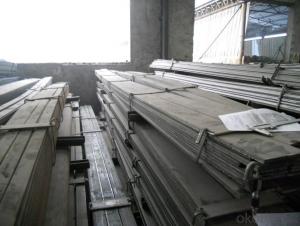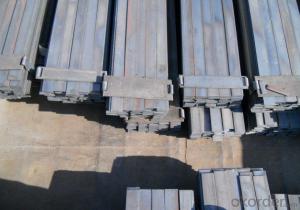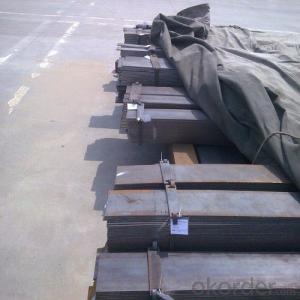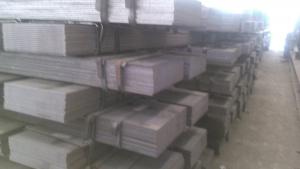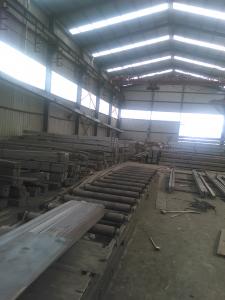Hot Rolled Wide Flat Steel 100mm*10mm*6m
- Loading Port:
- Tianjin
- Payment Terms:
- TT or LC
- Min Order Qty:
- 25 m.t.
- Supply Capability:
- 2000 m.t./month
OKorder Service Pledge
OKorder Financial Service
You Might Also Like
Product Description:
OKorder is offering Hot Rolled Wide Flat Steel 100mm*10mm*6m at great prices with worldwide shipping. Our supplier is a world-class manufacturer of steel, with our products utilized the world over. OKorder annually supplies products to European, North American and Asian markets. We provide quotations within 24 hours of receiving an inquiry and guarantee competitive prices.
Product Applications:
Hot Rolled Wide Flat Steel 100mm*10mm*6m are ideal for structural applications and are widely used in the construction of buildings and bridges, and the manufacturing, petrochemical, and transportation industries.
Product Advantages:
OKorder's Hot Rolled Wide Flat Steel 100mm*10mm*6m are durable, strong, and resist corrosion.
Main Product Features:
· Premium quality
· Prompt delivery & seaworthy packing (30 days after receiving deposit)
· Corrosion resistance
· Can be recycled and reused
· Mill test certification
· Professional Service
· Competitive pricing
Product Specifications:
Manufacture: Hot rolled
Grade: Q195 – 235
Certificates: ISO, SGS, BV, CIQ
Length: 6m – 12m, as per customer request
Packaging: Export packing, nude packing, bundled
Chinese Standard (H*W*T) | Weight (Kg/m) | 6m (pcs/ton) | Light I (H*W*T) | Weight (Kg/m) | 6m (pcs/ton) | Light II (H*W*T) | Weight (Kg/m) | 6M |
100*68*4.5 | 11.261 | 14.8 | 100*66*4.3 | 10.13 | 16.4 | 100*64*4 | 8.45 | 19.7 |
120*74*5.0 | 13.987 | 11.9 | 120*72*4.8 | 12.59 | 13.2 | 120*70*4.5 | 10.49 | 15.8 |
140*80*5.5 | 16.89 | 9.8 | 140*78*5.3 | 15.2 | 10.9 | 140*76*5 | 12.67 | 13.1 |
160*88*6 | 20.513 | 8.1 | 160*86*5.8 | 18.46 | 9 | 160*84*5.5 | 15.38 | 10.8 |
180*94*6.5 | 24.143 | 6.9 | 180*92*6.3 | 21.73 | 7.6 | 180*90*6 | 18.11 | 9.2 |
200*100*7 | 27.929 | 5.9 | 200*98*6.8 | 25.14 | 6.6 | 200*96*6.5 | 20.95 | 7.9 |
220*110*7.5 | 33.07 | 5 | 220*108*7.3 | 29.76 | 5.6 | 220*106*7 | 24.8 | 6.7 |
250*116*8 | 38.105 | 4.3 | 250*114*7.8 | 34.29 | 4.8 | 250*112*7.5 | 28.58 | 5.8 |
280*122*8.5 | 43.492 | 3.8 | 280*120*8.2 | 39.14 | 4.2 | 280*120*8 | 36.97 | 4.5 |
300*126*9 | 48.084 | 3.4 | 300*124*9.2 | 43.28 | 3.8 | 300*124*8.5 | 40.87 | 4 |
320*130*9.5 | 52.717 | 3.1 | 320*127*9.2 | 48.5 | 3.4 | |||
360*136*10 | 60.037 | 2.7 | 360*132*9.5 | 55.23 | 3 |
FAQ:
Q1: Why buy Materials & Equipment from OKorder.com?
A1: All products offered byOKorder.com are carefully selected from China's most reliable manufacturing enterprises. Through its ISO certifications, OKorder.com adheres to the highest standards and a commitment to supply chain safety and customer satisfaction.
Q2: How do we guarantee the quality of our products?
A2: We have established an advanced quality management system which conducts strict quality tests at every step, from raw materials to the final product. At the same time, we provide extensive follow-up service assurances as required.
Q3: How soon can we receive the product after purchase?
A3: Within three days of placing an order, we will begin production. The specific shipping date is dependent upon international and government factors, but is typically 7 to 10 workdays.
Q4: What makes stainless steel stainless?
A4: Stainless steel must contain at least 10.5 % chromium. It is this element that reacts with the oxygen in the air to form a complex chrome-oxide surface layer that is invisible but strong enough to prevent further oxygen from "staining" (rusting) the surface. Higher levels of chromium and the addition of other alloying elements such as nickel and molybdenum enhance this surface layer and improve the corrosion resistance of the stainless material.
Q5: Can stainless steel rust?
A5: Stainless does not "rust" as you think of regular steel rusting with a red oxide on the surface that flakes off. If you see red rust it is probably due to some iron particles that have contaminated the surface of the stainless steel and it is these iron particles that are rusting. Look at the source of the rusting and see if you can remove it from the surface.
Images:

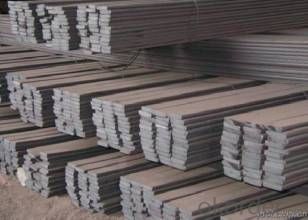
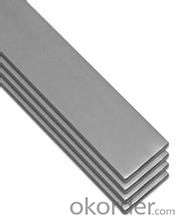
- Q:Can steel flat bars be used in architectural designs?
- Yes, steel flat bars can be used in architectural designs. They are versatile and can be used for various structural and decorative purposes such as framing, support beams, handrails, and cladding. Their durability, strength, and sleek appearance make them a popular choice in modern architectural designs.
- Q:What is the cost of a steel flat bar?
- The price of a steel flat bar may differ based on several factors, including its size, grade, and required quantity. To obtain an accurate cost, it is recommended to consult nearby suppliers or explore online retailers. The price range per bar can vary from a few dollars to several hundred dollars.
- Q:Can steel flat bars be used for manufacturing aerospace components?
- Yes, steel flat bars can be used for manufacturing aerospace components. Steel is a common material used in aerospace manufacturing due to its high strength and durability. Flat bars can be machined, formed, and welded to create various aerospace components such as brackets, supports, and structural elements. However, the specific grade and specifications of the steel should be carefully considered to meet the stringent requirements of the aerospace industry.
- Q:How do you prevent discoloration or staining on steel flat bars during fabrication?
- To avoid discoloration or staining on steel flat bars during fabrication, there are several steps that can be taken: 1. Store the steel flat bars in a clean, dry, and well-ventilated area. Rust and discoloration can occur due to moisture and humidity. Elevating the bars off the ground and covering them with a tarp or plastic wrap can provide additional protection against moisture. 2. Thoroughly clean the steel flat bars before fabrication to remove dirt, oil, or grease. Use a degreasing agent and scrub the bars with a stiff brush or abrasive pad. This will eliminate any contaminants that could cause discoloration during fabrication. 3. Apply a protective coating to prevent discoloration and staining. Options include anti-corrosion primers, rust inhibitors, or temporary protective tapes. These coatings create a barrier between the steel and the environment, preventing oxidation and surface contamination. 4. Work in a controlled environment with proper ventilation and temperature control when performing heat-related fabrication processes such as welding or cutting. Using inert gases like argon or nitrogen during welding can also prevent discoloration caused by oxidation. 5. Handle the steel flat bars with clean gloves or tools during fabrication. Fingerprints, dirt, or oils from hands can leave marks on the surface, leading to discoloration over time. Avoid dragging or sliding the bars on rough surfaces to prevent scratches or abrasions that may promote staining. By following these preventive measures, the likelihood of discoloration or staining on steel flat bars during fabrication can be significantly reduced. This ensures a high-quality finish and extends the lifespan of the fabricated steel components.
- Q:Are steel flat bars suitable for machine frames?
- Indeed, machine frames can generally be constructed using steel flat bars. Steel is renowned for its robustness, longevity, and ability to withstand wear and tear, which renders it a prevalent selection for machine frames across diverse industries. The flat and rectangular shape of steel flat bars proves especially advantageous for the construction of machine frames as it facilitates effortless welding and assembly. Moreover, steel flat bars provide exceptional stability and rigidity, ensuring that the machine frame can effectively bear the weight and vibrations produced during machine operation. In summary, steel flat bars furnish a dependable and solid base for machine frames, making them a fitting choice for this purpose.
- Q:How do steel flat bars compare to copper flat bars?
- Steel flat bars and copper flat bars are both versatile and widely used in various industries. However, they differ significantly in terms of their properties and applications. Firstly, steel flat bars are typically stronger and more durable than copper flat bars. Steel has a higher tensile strength and hardness, making it ideal for applications that require load-bearing and structural support. It can withstand heavy loads, making it suitable for construction, manufacturing, and automotive industries. On the other hand, copper flat bars are relatively softer and more malleable, making them better suited for electrical applications, such as wiring and circuitry. Secondly, steel flat bars have excellent corrosion resistance, especially when coated with protective materials like galvanized or stainless steel. This makes them suitable for outdoor applications where exposure to moisture, chemicals, and harsh weather conditions is expected. Copper, on the other hand, is naturally corrosion-resistant and forms a protective oxide layer, making it ideal for plumbing, electrical, and marine applications. Another notable difference is their thermal conductivity. Copper is an excellent conductor of heat and electricity, making it widely used in electrical wiring and heat exchangers. Steel, although not as efficient in conducting heat and electricity as copper, still possesses moderate thermal conductivity and finds applications in heating systems and heat transfer equipment. Furthermore, steel flat bars are generally more cost-effective compared to copper flat bars. Steel is abundantly available, making it less expensive than copper, which is a relatively scarce resource. This cost difference is one of the main reasons why steel is more commonly used in construction and manufacturing industries. In summary, steel flat bars are known for their strength, durability, corrosion resistance, and cost-effectiveness. They are commonly used in load-bearing applications and outdoor environments. Copper flat bars, on the other hand, are softer, more malleable, and possess excellent electrical conductivity. They are widely used in electrical and plumbing applications. Ultimately, the choice between steel and copper flat bars depends on the specific requirements of the application at hand.
- Q:Can steel flat bars be used as structural support in buildings?
- Yes, steel flat bars can be used as structural support in buildings. Steel is known for its strength and durability, making it a popular choice for structural applications. Flat bars can be used to provide support and stability in various building elements such as beams, columns, and frames. Additionally, steel flat bars can be easily fabricated and customized to meet specific design requirements, further enhancing their suitability for structural support in buildings.
- Q:What is the use of slitting flat steel?
- Compared with the conventional steel plate, slitting flat steel has the following advantages:1, the product surface is bright and clean. Two times in the process of high-pressure water descaling process, to ensure that the steel surface clean and bright.2, special product specifications. The thickness of 8~45mm, width 150-600mm, length 5-15m, and the product specifications span is dense, can meet the needs of users, instead of in use, without cutting board, we can directly carry out welding.3, both sides of the vertical, clear water chestnut. The two vertical rolling in the finishing mill ensures good verticality of both sides, clear corners and good quality of the edges.
- Q:Can steel flat bars be used for making hand tools or equipment?
- Yes, steel flat bars can be used for making hand tools or equipment. Steel is a strong and durable material that is commonly used in the manufacturing of various tools and equipment. Flat bars are versatile and can be easily shaped and formed into different designs and sizes to meet the specific requirements of hand tools or equipment. Additionally, steel flat bars provide excellent strength and stability, making them suitable for applications where durability and reliability are essential. Furthermore, steel is resistant to corrosion, which ensures that the hand tools or equipment made from steel flat bars will have a longer lifespan. Overall, steel flat bars are a popular choice for making hand tools or equipment due to their strength, versatility, and durability.
- Q:What are the different grades of steel used in flat bars?
- The different grades of steel used in flat bars can vary, but some commonly used grades include mild steel, carbon steel, stainless steel, and alloy steel. These grades are chosen based on the specific requirements of the intended application, such as strength, corrosion resistance, and durability.
1. Manufacturer Overview |
|
|---|---|
| Location | |
| Year Established | |
| Annual Output Value | |
| Main Markets | |
| Company Certifications | |
2. Manufacturer Certificates |
|
|---|---|
| a) Certification Name | |
| Range | |
| Reference | |
| Validity Period | |
3. Manufacturer Capability |
|
|---|---|
| a)Trade Capacity | |
| Nearest Port | |
| Export Percentage | |
| No.of Employees in Trade Department | |
| Language Spoken: | |
| b)Factory Information | |
| Factory Size: | |
| No. of Production Lines | |
| Contract Manufacturing | |
| Product Price Range | |
Send your message to us
Hot Rolled Wide Flat Steel 100mm*10mm*6m
- Loading Port:
- Tianjin
- Payment Terms:
- TT or LC
- Min Order Qty:
- 25 m.t.
- Supply Capability:
- 2000 m.t./month
OKorder Service Pledge
OKorder Financial Service
Similar products
New products
Hot products
Hot Searches
Related keywords









